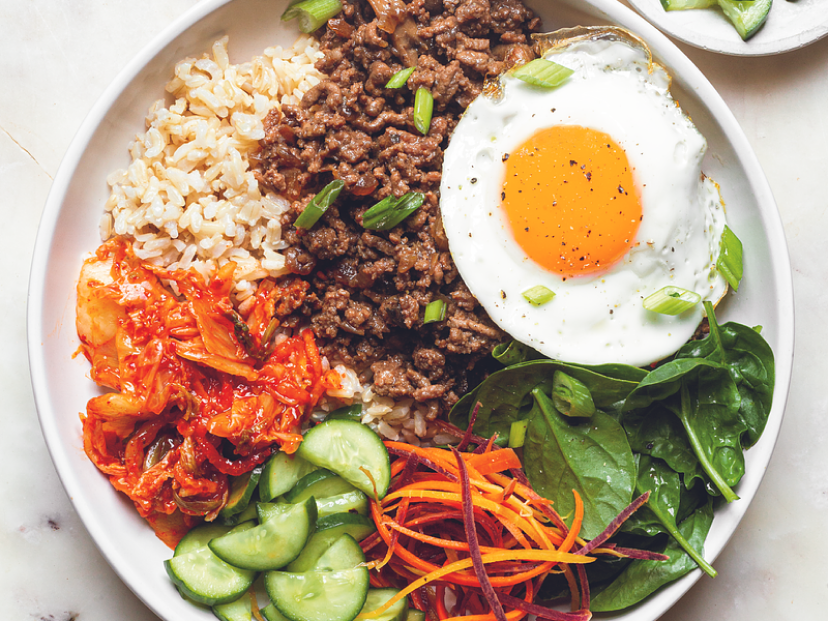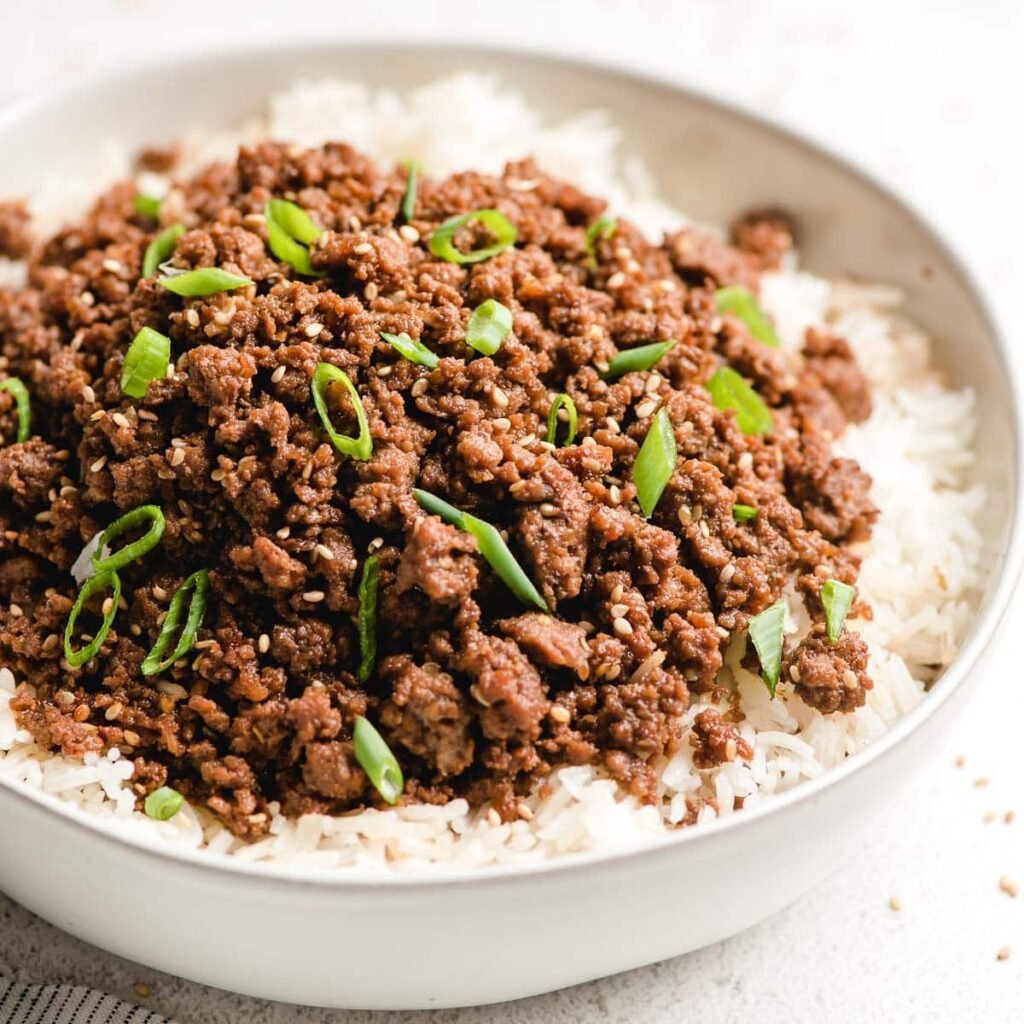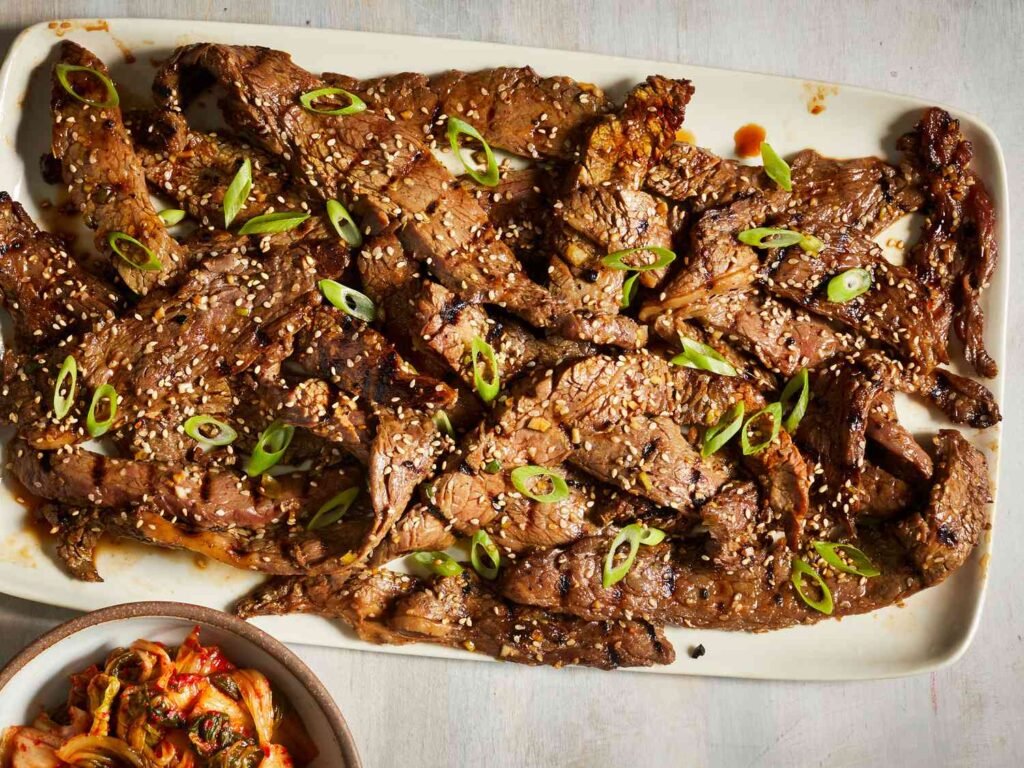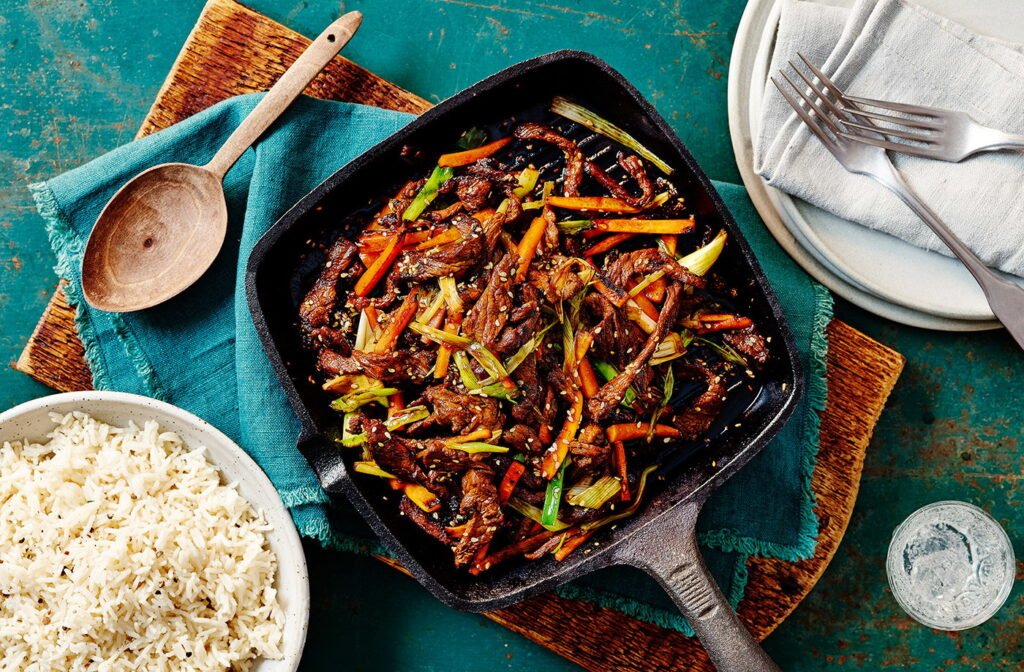Bulgogi: A Slice of Korean BBQ Heaven
Bulgogi, also known as Korean BBQ beef, is a dish that will tantalize your taste buds and transport you straight to the heart of Korea. Thinly sliced, marinated steak is grilled to juicy perfection, boasting a beautiful balance of sweet, savory, and umami flavors.
This recipe is not just delicious, it’s incredibly easy to make at home. With minimal prep time and a short cook time, you can whip up restaurant-quality bulgogi in under an hour and fifteen minutes.
So, are you ready to experience the magic of bulgogi? Let’s dive deeper!
What Exactly is Bulgogi?
The word “bulgogi” literally translates to “fire meat” in Korean. Traditionally, it’s made with thin slices of beef that are marinated in a sweet and savory sauce before being grilled or pan-fried. Bulgogi can also be made with pork or chicken, although beef is the most common variation.
The key to bulgogi’s flavor lies in the marinade. This flavorful concoction typically includes soy sauce, sugar, garlic, sesame oil, and aromatics like green onion and ginger. The marinade not only tenderizes the meat but also infuses it with incredible depth of flavor.
Bulgogi Pronunciation 101
Now that you know what bulgogi is, let’s master its pronunciation. Here’s a helpful breakdown:
- Bul is pronounced like the “bull” in “bulldog.”
- Go is pronounced like the “go” in “goalie.”
- Gi is pronounced like the “gee” in “gee whiz.”
So, the next time you order bulgogi at a Korean restaurant, you can impress your friends with your perfect pronunciation!

Essential Ingredients for Bulgogi Bliss
The beauty of bulgogi lies in its simplicity. You can make this dish with just a handful of ingredients that you might already have on hand. Here’s what you’ll need:
- Steak: Flank steak is the classic choice for bulgogi. It’s thin, flavorful, and becomes incredibly tender after marinating. However, you can also use skirt steak or hanger steak for equally delicious results.
- Soy Sauce: This forms the base of the marinade, providing a salty and umami foundation.
- Sugar: A touch of sugar helps balance the savory flavors of the soy sauce and creates a delightful caramelization during grilling.
- Green Onion and Garlic: These aromatics add depth and complexity to the marinade.
- Sesame Seeds: Toasted or untoasted, sesame seeds add a nutty richness and a satisfying textural contrast.
- Sesame Oil: Use good quality sesame oil for the best flavor. It imparts a distinct nutty aroma and taste that complements the other ingredients beautifully.
- Black Pepper: A sprinkle of black pepper adds a touch of heat and rounds out the flavor profile.
Optional Ingredients:
- Korean Pear: Grated Korean pear adds natural sweetness and helps tenderize the meat.
- Gochujang: This Korean chili paste can be added for a spicy kick.
The Art of Bulgogi Making: A Step-by-Step Guide
Making bulgogi is a breeze. Here’s a step-by-step guide to help you achieve Korean BBQ perfection:
- Marinate the Steak:
- Place your thinly sliced steak in a shallow bowl.
- In a separate bowl, whisk together the soy sauce, sugar, chopped green onion, minced garlic, sesame seeds, sesame oil, and black pepper.
- Pour the marinade over the steak, ensuring all the pieces are well coated.
- Cover the bowl and refrigerate for at least an hour, or ideally overnight for maximum flavor.
- Prepare for Grilling:
- Preheat your grill to high heat. If using a grill pan, heat it over medium-high heat on your stovetop.
- Lightly oil the grates or pan to prevent sticking.
- Grill to Perfection:
- Once the grill or pan is hot, add the marinated steak slices in a single layer.
- Cook for 1-2 minutes per side, or until the steak is nicely charred and cooked through. Be careful not to overcook, as the steak can become tough.
- Serve and Savor:
- Once cooked, remove the steak from the heat and let it rest for a few minutes before serving.
There you have it! Restaurant-quality bulgogi made in the comfort of your own home.

Bulgogi Accompaniments: The Perfect Pairing
Bulgogi is traditionally served with rice and lettuce wraps. The lettuce cups act as edible vessels for the flavorful bulgogi, and the rice provides a bed for soaking up all the delicious juices. But the options extend far beyond the basics. Here are some fantastic accompaniments to elevate your bulgogi experience:
- Gochujang: This fiery Korean chili paste adds a spicy kick to your bulgogi. You can serve it on the side as a condiment or drizzle some directly over your bulgogi for an extra punch.
- Kimchi: This fermented spicy cabbage is a staple in Korean cuisine. Its tangy, spicy, and slightly sour flavor perfectly complements the richness of bulgogi.
- Ssamjang: This thick and savory dipping sauce is a combination of gochujang, doenjang (Korean soybean paste), sesame oil, garlic, and other ingredients. It adds a complex flavor profile to your bulgogi.
- Korean Banchan (Side Dishes): A variety of small Korean side dishes called banchan can complement your bulgogi. Some popular options include kongnamul (bean sprouts), oi muchim (cucumber salad), japchae (glass noodles), and kimchi jjigae (kimchi stew).
- Vegetables: Grilled or roasted vegetables like onions, peppers, and mushrooms pair beautifully with bulgogi.
Serving Suggestions:
- Lettuce Wraps: As mentioned earlier, lettuce wraps are a traditional way to enjoy bulgogi. Pile some bulgogi, rice, kimchi, and your favorite toppings into lettuce leaves and enjoy a delicious and healthy bite.
- Bulgogi Bowls: Serve bulgogi over a bed of rice, with your favorite toppings like gochujang, kimchi, seaweed (gim), and a fried egg for a complete and satisfying meal.
- Korean BBQ at Home: Bulgogi is a fantastic option for a fun and interactive Korean BBQ experience at home. Prepare the bulgogi and all the accompaniments, and let your guests cook the meat on a tabletop grill or grill pan for a personalized dining experience.
Bulgogi Storage and Leftovers:
Leftover bulgogi can be stored in an airtight container in the refrigerator for up to four days. Reheat it gently in a skillet or microwave until warmed through. You can also freeze cooked bulgogi for up to three months. Thaw it overnight in the refrigerator before reheating.
Bulgogi Variations: A World of Flavor
The beauty of bulgogi lies in its versatility. Here are some popular variations to explore:
- Spicy Bulgogi: Add some gochujang to the marinade for a spicy kick. You can adjust the amount to your desired level of heat.
- Chicken Bulgogi: Substitute thinly sliced chicken breast or thighs for the beef in this recipe.
- Pork Bulgogi: Similar to chicken bulgogi, use thinly sliced pork shoulder or belly for a different flavor experience.
- Bulgogi Marinade Variations: Experiment with different ingredients in the marinade. You can add grated Korean pear for extra tenderness, a touch of ginger for a warming flavor, or a splash of honey for a deeper sweetness.

Reader-Recommended Tips:
- “I don’t have good knives for thin slicing. I marinate my bulgogi overnight, and the meat tenderizes enough that I can slice it thinly without any problems.” – SummerSandals (Allrecipes Community)
- “Brown sugar works great in place of white sugar. It takes a little longer to dissolve in the marinade, so make sure it’s fully incorporated before adding it to the meat.” – SummerSandals (Allrecipes Community)
- “Leftover bulgogi is fantastic in fried rice or lettuce wraps for lunch the next day!” – Corinne (Allrecipes Community)
With this comprehensive guide, you’re now equipped to create restaurant-worthy bulgogi at home. So, fire up your grill, gather your favorite accompaniments, and get ready to experience the magic of Korean BBQ!
Nutrition Facts (per serving)
| 232 | Calories |
| 13g | Fat |
| 12g | Carbs |
| 16g | Protein |
| Nutrition Facts | |
|---|---|
| Servings Per Recipe 4 | |
| Calories 232 | |
| % Daily Value * | |
| Total Fat 13g | 17% |
| Saturated Fat 3g | 15% |
| Cholesterol 27mg | 9% |
| Sodium 1157mg | 50% |
| Total Carbohydrate 12g | 5% |
| Dietary Fiber 1g | 4% |
| Total Sugars 8g | |
| Protein 16g | 32% |
| Vitamin C 3mg | 3% |
| Calcium 68mg | 5% |
| Iron 2mg | 12% |
| Potassium 269mg | 6% |
* Percent Daily Values are based on a 2,000 calorie diet. Your daily values may be higher or lower depending on your calorie needs.
** Nutrient information is not available for all ingredients. Amount is based on available nutrient data.
(-) Information is not currently available for this nutrient. If you are following a medically restrictive diet, please consult your doctor or registered dietitian before preparing this recipe for personal consumption.
Powered by the ESHA Research Database © 2018, ESHA Research, Inc. All Rights Reserved

